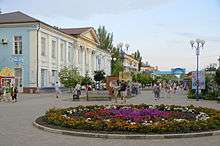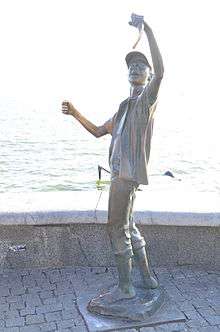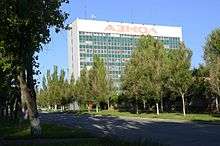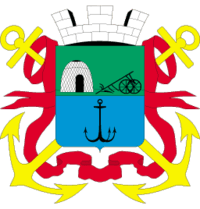Berdiansk
| Berdyans'k Бердянськ | |||
|---|---|---|---|
 | |||
| |||
 Berdyans'k Location of Berdyansk | |||
| Coordinates: 46°45′35″N 36°47′04″E / 46.75972°N 36.78444°ECoordinates: 46°45′35″N 36°47′04″E / 46.75972°N 36.78444°E | |||
| Country |
| ||
| Oblast |
| ||
| Raion | Berdiansk City Municipality | ||
| Founded | 1827 | ||
| City rights | 1835 | ||
| Government | |||
| • Mayor | Oleksiy Bakay | ||
| Area | |||
| • Total | 82.65 km2 (31.91 sq mi) | ||
| Elevation | 10 m (30 ft) | ||
| Population (2013) | |||
| • Total | 116,034 | ||
| • Density | 1,400/km2 (3,600/sq mi) | ||
| Postal code | 71100-71127 | ||
| Area code(s) | (+380) 6153 | ||
| Vehicle registration | AP/08 | ||
| Climate | Cfa | ||
| Website | City Council Official website | ||
Berdyansk, or Berdiansk, (Ukrainian: Бердя́нськ, Russian: Бердя́нск) is a port city in the Zaporizhia Oblast (province) of south-east Ukraine. It is located on the northern coast of the Sea of Azov, which is the northern extension of the Black Sea. It serves as an administrative center of Berdyansk Raion, though it does not belong to the region. The city is named after the river Berda forming Berdyanskaya spit at the foot of which it is located.[1] Berdyansk is a very attractive place, home to a safari zoo, water park, museums, health resorts with mud baths and climatic treatments, and numerous water sport activities.
Name
Its original name was Kutur-Ogly. The neighboring settlement was known as Berdy. The city name changed to Novo-Nogaisk in 1830 (New Nogaisk) (see Nogai). The present name was given to the city in 1841 by special decree of Nicholas I. Between 1939 and 1958 the city was known as Osipenko, so named after Hero of the Soviet Union Polina Osipenko.[2] This name has now been given to the nearby village Osipenko where Polina Osipenko was born.
History
In 1824, Count Mikhail Vorontsov, Governor General of the Caucasus Viceroyalty, sent an expedition to the Azov Sea. Its task was to find a place to build a new seaport to assist in the defence of Russia's southern borders. In the autumn of 1824 Captain Kritsky, the expedition supervisor, reported on several prospective sites; the best being a place closed off from the sea by the Berdyansk Spit. In an official report to Vorontsov, Kritsky wrote: "the quality of Berdyansk Spit surpasses that of Obitochnaya Spit; you can build a landing stage and port on it unless you concede to Sevastopol...".[3]
On November 3, 1827, the act was issued separating land for the city and the pier, and the construction of a large marina began. 1827 is officially considered the year of foundation of Berdyansk (the 180th anniversary of the city took place in 2007). The marina opening ceremony took place on July, 1st, 1830. The new port authority quickly grew and Berdyansk was granted city status in 1835.
In 1838, the Nizhneberdiansky beacon was built. It is a 23-metre octahedral whitestone tower with an orange stripe in the middle. The beacon fires protected sailing ships and was first seen in 1840. Almost half a century later, in 1883, the oil lamps were replaced by electric lights. The old beacon was refurbished and upgraded with newer equipment. It remains on watch, lighting the way for ships along the nearby coast.
1842 Berdyansk became the district center. On January 31, 1845, the first Berdyansk coat of arms was created. At the top, on a green field, is a silver Nogay's nomadic tent together with a black plow; this denotes the semi-nomadic life lived in the Nogays and farming work done by local residents. In the bottom part, on a blue field, sits a black anchor to symbolize the district's affinity with the sea. By this time the customs outpost was already opened. Some foreign marine grain purchasing representatives (negotiators) moved their offices to Berdyansk from Mariupol and Odessa.
Development
The city developed and grew, though construction was random and haphazard. In the center, private residences for the nobility, merchants, priests were built, as well as office accommodation. Suburbs arose in the outskirts of Berdyansk, such as: Sailor, German, Soldier (Liska), Dog beam Havrylivka, and Near and Far Makorty.
In April 1862 Tsar Alexander II with assistance from the Mayor N. Kobozev confirmed the city district plan for Berdyansk. In the plan the streets were straight and led to the sea. This layout has remained to the present day in the central part of the city. It was forbidden to build houses above the second floor. Fine buildings decorate Berdyansk: the Winter Theatre, City Hall, the hotel "Bristol" (now House of Culture factory "Pivdenhidromash"), male classical school (now the main building of the Pedagogical Institute), Ascension Cathedral, the Lutheran Church and more.
In Berdyansk the main employer was still the seaport, and on March 24, 1869 the breakwater was commissioned. This stone building is 640 metres (2,100 feet) long with two port lights on the ends – pointers to the harbor, located at a distance of 859 metres (2,818 feet) from the shore. The increasing importance of the port was mentioned in 1867 in a commemorative book on the Taurian province: "Already there is no doubt, that for all the Azov coast the Berdyansk port will be the Odessa of the Black Sea coast".
In 1876 as part of the defense of Sevastopol, rear admiral P. P. Schmidt was appointed Town Governor and Port Chief. Being a progressive man, he did much to promote the development of both port and city. Soon there were small industrial enterprises and banks opening in the city. D. Grievza's factory manufacturing harvesters became well known across Europe. A farming machine factory was opened by Schröder and Matias. There was the rope-making factory of Venz and Yanzen, Selstrem's candle-wax works, Litsmen sausage factory, Fetter's brewery, Klavdin macaroni factory, and Ediger's printing house. The Italians constructed the city power station. By this time, two daily newspapers, three libraries and four bookshops were established. The city had running water and electric light illumination.
In 1899 Berdyansk was linked up to the railway. At the beginning of the 20th century the city population numbered 26,500. There were about ten orthodox temples, two Jewish and one Karaite synagogue, boys and girls grammar schools, nautical classes, a city college and some credit institutions. In addition to an extensive export trade in mainly grain and flour, Berdyansk conducted large amounts of inland trade. It became a substantial distributive market for goods received over a wide area. By the beginnings of the 20th century, Berdyansk had become a merchant trading port with well developed industry, strongly influenced by its infrastructure.
Geography
Berdyansk is located in a steppe zone that defines its varieties of flora and fauna. The climate on the Azov coast is unique: the summers are hot and dry, the winters are mild and warm. The main natural feature is the end of the Berdyansk spit. The spit flora is quite diverse. Here one can find more than 300 different kinds of plants. Some of them are documented in the Red Book (e.g. Carex colchica, Åryngium maritimum, Glycyrrhiza glabra). The vegetation is mostly made up of plants with powerful root systems.
In spite of the fact that the spit is a populous territory, it exhibits a wide variety of fauna. Here it is possible to see hares, hedgehogs, martens, foxes, weasels and steppe cats. There also are: geese, sandpipers, swans, herons, ducks, magpies, seagulls, cormorants, warblers, lapwings, red-breasted geese and mute swans. Their numbers swell during the migration season. The islands of Big Dzendzik and Small Dzendzik, small islands in the Astapih's archipelago, contain most of the birds.
Sea water temperatures off Berdyansk are higher than the Black Sea coast of the Crimea and the Caucasus. Already in May, the water warms up to 22 °C (72 °F), and in June it can reach 30 °C (86 °F). In the sea there are more than 70 fish species amongst them great sturgeon, Russian sturgeon, starred sturgeon, Azov turbot, haarder, mullets, kilka, anchovy, sea roach, shemaya and various species of gobies. There are predators too, pike perch and sterlet. The phytoplankton consists of diatomaceous, peridinium and cyanobacteria algae. At the bottom of the sea are large quantity of molluscs, such as cockles, sendesmiya, mussels and myas. They form an important food source for the fish. In coastal waters there are also dolphins.
Demographics
| Historical population | ||
|---|---|---|
| Year | Pop. | ±% |
| 1860 | 10,100 | — |
| 1897 | 26,500 | +162.4% |
| 1926 | 26,400 | −0.4% |
| 1939 | 52,000 | +97.0% |
| 1959 | 65,000 | +25.0% |
| 1970 | 100,000 | +53.8% |
| 2001 | 121,000 | +21.0% |
Note: Historical population record is taken out of Encyclopedia of Ukraine (in English).
Culture
In the city of Berdyansk there are several art museums, Schmidt's Museum, Museum of World War II and Berdyansk History Museum.It is a host city to more than ten festivals a year. The list includes:
- the Azov Summer Ukrainian Journalism Festival
- the Brigantine Film Festival
- the Berdyansk Jazz Festival
- the Hilarious by the Dark Blue Sea Comedy Festival
- the Top-Top Children's Talent Festival
- the Starfall Children's Pop Music Festival
- Berdyansk Folk and Religious Music Festival
- the Heat of the Sun Festival
- the Azov Sails Televised Children's Talent Festival
- the Rock'n'roll Slavic Soul Festival,
- the Beer Festival




.jpg)
Monuments
Berdyansk has unusual monuments. Along with monuments to Alexander Pushkin and Schmidt there are monuments to the goby-supporter, the sanitary technician, the boy-fisherman, an envious toad, and the children of lieutenant Schmidt. The armchair of desires is also popular. It is said if one sits down on it and thinks of a desire then it will come true. These unusual monuments are being restored on Azov avenue.


Tourism

at the tip of Berdiansk spit by Sea of Azov
The status of the city has gradually changed from an Industrial centre to more of a tourist centre. Today Berdyansk is the main resort city on the Azov coast. Its population numbers about 130 thousand, and during the resort season this figure rises to about 600 thousand. The leisure facilities are highly developed and successfully compete with resorts on the Black Sea Coast and the Crimea. There are a large number of sanatoriums and resorts where it is possible to take medical and restorative courses for "health improvement".
On the Berdyansk spit there are about: 7 sanatoriums, 17 children's and sports establishments, 45 recreation centres and boarding houses that receive up to 15 thousand persons. There is also the biggest Aquapark in Europe, the Kiev dolphinarium, a safari zoo, and a lot of pleasure and cultural establishments. Gradually Berdyansk is evolving into a modern European city. In 2001 it received first place in an All-Ukrainian competition for best city beautification.
In the pedestrian area of Azov Avenue, the Seaside square and Berdyansk quays it is possible to travel on trishaws, a small steam locomotive and on real horses. On all beaches there are entertainments such as: driving on rubber bananas and tablets, water bicycles and motorcycles, slides and trampolines, and sailing. There is also nightlife, with many bars and restaurants located directly on the sea coast.
Economy
One of the main enterprises is the sea trading port, with clients from all over the world. It carries out metal processing, scrap metal, grain, coal, ore, clay, sunflower-seed oil, industrial oils, mineral oil, and pig-iron. There is a complex for processing fertilizers and mineral oil, the container terminal, and a railway depot. Tracks and roads approach all moorings, and all are equipped with electric cranes. Depth in port water area is 8.4 metres (28 feet).
Berdyansk is also an important fisheries centre which is an integral part of the city's food industry. There is also a scientific organisation which does fish research in reservoirs of the Azov basin. It determines stock levels and calculates the annual volumes of withdrawal of such valuable food fish as sturgeon, pike perch, haarder, Azov turbot, Azov gobies, and flounder."Azov centre YugNIRO"
Industry
During the Soviet period Berdyansk was a powerful industrial centre. There were machine factories of all types, an oil refinery, a fiberglass factory, cable factory, ferroconcrete combine, factory of materials handling equipment, provisions factory, a bread-baking complex, milk plant, a meat-packing plant, a considerable quantity of construction and mounting organizations, commodity railway station and the sea trading port. However, in the early independence years the majority of the large industrial enterprises ceased or were reorganised into smaller private concerns.

Chemical and the petroleum-refining industry is represented by two big enterprises: "AZMOL", and the Berdyansk state fiberglass factory, plus two small enterprises: Limited Liability Company "Fibreglass" and Closed Corporation "Bertie". Public corporation"AZMOL"is engaged in the manufacture of lubricants and packaging, and the development of new products using energy-efficient technologies. Transfer to municipal ownership of the city biological sewage treatment plant is planned.
Education
As well as the state comprehensive schools there are private lyceums and gymnasiums, as well as branches of other high schools and professional colleges. There is the Berdyansk State Pedagogical University and the University of Management and Business. In the Schmidt park there is the Berdyansk musical school, and nearby, almost on the coast, an art school. A subject of pride in Berdyansk is the Centre of Children's and Youthful Creativity, numbering a large quantity of study groups and ensembles.
Twin towns – sister cities
Berdiansk is twinned with:
 Bielsko-Biała in Poland [4]
Bielsko-Biała in Poland [4] Yambol in Bulgaria [5]
Yambol in Bulgaria [5] La Seyne-sur-Mer in France
La Seyne-sur-Mer in France
Notable residents
- Opanas Slastion, Ukrainian painter
- Isaak Brodsky (1883–1939), a painter, a teacher and organizer of Art education in 30th years of 20th century. He was an Honoured Artist of the Russian SFSR and a member of the Union of Russian Artists
- Lidiya Chernysheva (1912–1875), a ballet dancer, People's Artist of the USSR
- Joel Engel (1868—1927), composer, teacher and organizer, one of the founders of the Jewish art music movement.
- Waldemar Haffkine (1860–1930), a well-known doctor. He created the first effective anti-cholera vaccine. He also made a large contribution to the struggle against bubonic plague which involved Bombay (India) in 1898[6]
- Peter Jansen, (1852–1923) born in Berdiansk, rancher and founder of Jansen, Nebraska, State Representative and Senator
- Piotr Szymański, (1900–1965) lived in Berdiansk from 1915–1921, Polish Ambassador in Romania, Professor at Warsaw Polytechnic
- Olga Kurylenko, a model and actor, and James Bond girl in Quantum of Solace, was born and raised in Berdiansk.
- Tatyana Nazarova (1960), People's Artist of Ukraine and Russia, prima- actress of Lesya Ukrainka National Academic Theater of Russian Drama (Kiev)
- Polina Osipenko, a Hero of the Soviet Union, was born in a nearby village of Osypenko. Polina Osipenko was a military pilot, who set several flight world records including the longest non-stop flight ever completed by a woman in 1938.[2]
- Vitaly Papazov (1980), a champion (in 2002) and the world record-holder in powerlifting
- Tatyana Prorochenko (1952), an athlete who competed mainly in the 400 metres, an olympic champion (in 1976 and 1980)
- Roman Sevasteev, the World (in 1993) Champion on heavy athletics
- Mikhail Voskresensky (1935), a pianist, People's Artist of Russia, professor at the Moscow State Conservatory
References
- ↑ "Berdyansk city, Ukraine travel guide". ukrainetrek.com. Retrieved 2016-12-17.
- 1 2 Осипенко, Полина Денисовна, Wikipedia
- ↑ "History :: Berdyansk City Council – Official". bmr.gov.ua. Retrieved 2016-12-17.
- ↑ "Bielsko-Biała – Partner Cities". © 2008 Urzędu Miejskiego w Bielsku-Białej. Retrieved 2008-12-10.
- ↑ "Yambol – Partner Cities". ©. Retrieved 2010-03-22.
- ↑ Hanhart, Joel (2016). Waldemar Mordekhai Haffkine (1860–1930). Honore Champion.
External links
| Wikimedia Commons has media related to Berdyansk. |

